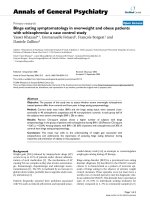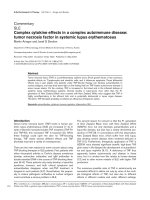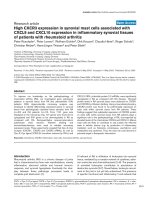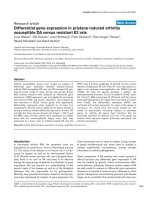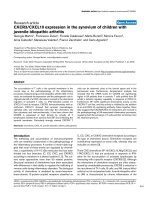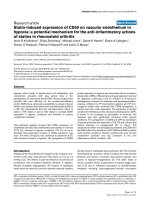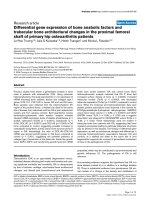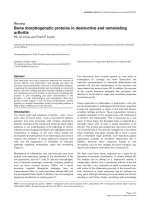Báo cáo y học: "Catabolic cytokine expression in degenerate and herniated human intervertebral discs: IL-1β and TNFα expression profile Christine Lyn Le Maitre, Judith Alison Hoyland and Anthony J Freemont" ppsx
Bạn đang xem bản rút gọn của tài liệu. Xem và tải ngay bản đầy đủ của tài liệu tại đây (2.86 MB, 11 trang )
Open Access
Available online />Page 1 of 11
(page number not for citation purposes)
Vol 9 No 4
Research article
Catabolic cytokine expression in degenerate and herniated
human intervertebral discs: IL-1β and TNFα expression profile
Christine Lyn Le Maitre, Judith Alison Hoyland and Anthony J Freemont
Tissue Injury and Repair Group, School of Medicine, Faculty of Medical and Human Sciences, The University of Manchester, Oxford Road,
Manchester M13 9PT, UK
Corresponding author: Judith Alison Hoyland,
Received: 15 May 2007 Revisions requested: 28 Jun 2007 Revisions received: 10 Jul 2007 Accepted: 9 Aug 2007 Published: 9 Aug 2007
Arthritis Research & Therapy 2007, 9:R77 (doi:10.1186/ar2275)
This article is online at: />© 2007 Le Maitre et al.; licensee BioMed Central Ltd.
This is an open access article distributed under the terms of the Creative Commons Attribution License ( />),
which permits unrestricted use, distribution, and reproduction in any medium, provided the original work is properly cited.
Abstract
Low back pain is a common and debilitating disorder. Current
evidence implicates intervertebral disc (IVD) degeneration and
herniation as major causes, although the pathogenesis is poorly
understood. While several cytokines have been implicated in the
process of IVD degeneration and herniation, investigations have
predominately focused on Interleukin 1 (IL-1) and tumor
necrosis factor alpha (TNFα). However, to date no studies have
investigated the expression of these cytokines simultaneously in
IVD degeneration or herniation, or determined which may be the
predominant cytokine associated with these disease states.
Using quantitative real time PCR and immunohistochemistry we
investigated gene and protein expression for IL-1β, TNFα and
their receptors in non-degenerate, degenerate and herniated
human IVDs. IL-1β gene expression was observed in a greater
proportion of IVDs than TNFα (79% versus 59%). Degenerate
and herniated IVDs displayed higher levels of both cytokines
than non-degenerate IVDs, although in degenerate IVDs higher
levels of IL-1β gene expression (1,300 copies/100 ng cDNA)
were observed compared to those of TNFα (250 copies of
TNFα/100 ng cDNA). Degenerate IVDs showed ten-fold higher
IL-1 receptor gene expression compared to non-degenerate
IVDs. In addition, 80% of degenerate IVD cells displayed IL-1
receptor immunopositivity compared to only 30% of cells in non-
degenerate IVDs. However, no increase in TNF receptor I gene
or protein expression was observed in degenerate or herniated
IVDs compared to non-degenerate IVDs. We have
demonstrated that although both cytokines are produced by
human IVD cells, IL-1β is expressed at higher levels and in more
IVDs, particularly in more degenerate IVDs (grades 4 to 12).
Importantly, this study has highlighted an increase in gene and
protein production for the IL-1 receptor type I but not the TNF
receptor type I in degenerate IVDs. The data thus suggest that
although both cytokines may be involved in the pathogenesis of
IVD degeneration, IL-1 may have a more significant role than
TNFα, and thus may be a better target for therapeutic
intervention.
Introduction
Intervertebral disc (IVD) degeneration and IVD herniation are
major causes of low back pain (LBP) [1], which is a common,
debilitating and economically important disorder [2,3]. How-
ever, none of the current treatments for LBP are directed at the
altered cell and matrix biology underlying IVD degeneration or
IVD herniation. Recent advances in therapeutics, particularly
cell and tissue engineering, offer potential methods for inhibit-
ing or reversing IVD degeneration, which has not previously
been possible. However, the pathogenesis of IVD degenera-
tion and IVD herniation is still not fully understood, and a
greater understanding is necessary before such therapies can
be fully developed for successful translation in the clinic.
The cells of the IVD behave abnormally during IVD degenera-
tion, with decreased synthesis of the normal IVD matrix and
increased production of degradative enzymes leading to a loss
of the normal homeostatic metabolism in the IVD [4-7]. As a
result there is destruction of the matrix with loss of hydration,
resulting in spinal instability and a reduced ability to withstand
load. Furthermore, IVD degeneration can also precede hernia-
tion of the IVD, which results in local nerve irritation, inflamma-
tion and further pain. In addition to the matrix degrading
enzymes, these catabolic processes are thought to be medi-
ated by a number of soluble mediators, including IL-1, tumour
necrosis factor TNFα, IL-6, IL-8 and prostaglandin E
2
[8-10].
Of these, the cytokines IL-1 and TNFα have been the focus of
a number of studies investigating the pathogenesis of IVD
degeneration, herniation and sciatic pain [11-20]. TNFα has
been linked to IVD herniation and nerve irritation by a number
of studies and the outcome of recent experiments using TNFα
Arthritis Research & Therapy Vol 9 No 4 Le Maitre et al.
Page 2 of 11
(page number not for citation purposes)
inhibitors has implicated this cytokine as an important media-
tor in LBP [15-20], whilst IL-1 has been shown to be directly
involved in the decreased matrix synthesis and increased
matrix degradation associated with IVD degeneration [12].
Importantly, elevated levels of IL-1 and TNFα have been found
in aged and degenerative IVDs from both animal models and
humans [12,21,22]. We have previously demonstrated the
synthesis of IL-1α, IL-1β, IL-1 receptor type I (RI), IL-1β con-
verting enzyme and IL-1Ra by the resident chondrocyte-like
cells in human IVDs with significant increases in IL-1α, IL-1β,
IL-1RI and IL-1β converting enzyme, but not IL-1Ra, during IVD
degeneration [12]. Weiler and colleagues [21] found a posi-
tive correlation between TNFα and IVD degeneration, with
approximately 80% of nucleus pulposus (NP) and 75% of
annulus fibrosus (AF) cells staining positively for this cytokine.
However, although Weiler and colleagues demonstrated an
increase in TNFα immunopositivity in surgical samples com-
pared to autopsy controls, the surgical samples were derived
from a mixture of both herniated and degenerate IVDs and,
thus, it was unclear from this study whether increased TNFα
immunopositivity was observed in both disorders or just in her-
niation [21]. A recent study by Bachmeier and colleagues [22]
also investigated the protein expression of TNFα, TNF recep-
tors and the TNFα activating enzyme TACE in human IVD and
demonstrated expression of all four molecules. Interestingly,
although TNFα receptors were observed in autopsy samples,
no results were presented for TNF receptor expression in sur-
gical samples, thus raising the question as to whether TNFα is
biologically active in such samples [22].
Thus, to date, it is not apparent whether both cytokines are
involved in IVD degeneration or herniation and, if so, whether
one has a predominant role in each disease state, an important
question if future therapies are to be successful at targeting
the processes involved in IVD degeneration and herniation.
Here, we use fully quantitative real time PCR and immunohis-
tochemistry to investigate the gene and protein expression of
IL-1β, TNFα and their receptors in non-degenerate, degener-
ate and herniated human IVDs to investigate whether both
cytokines are expressed during IVD degeneration and hernia-
tion, and whether one may have a more predominant role.
Materials and methods
Tissue selection and grading of IVDs
Human IVD tissue was obtained either at surgery or post-mor-
tem examination with informed consent of the patient or rela-
tives. Local research ethics committee approval was given for
this work by the following Local Research Ethics Committees:
Salford and Trafford (Project number 01049), Bury and Roch-
dale (BRLREC 175(a) and (b)), Central Manchester (Ref No:
C/01/008) and her Majesty's coroner (LMG/RJ/M6).
Post-mortem tissue
Previous studies have shown that IVD cells remain viable for at
least 48 hours following death. In all, 8 IVDs were recovered
from 6 patients within 18 hours of death (Table 1). They con-
sisted of full thickness wedges of IVD of 120° of arc removed
anteriorly, allowing well-orientated blocks of tissue to be cut
for histological study. Patients with a history of sciatica or low
back pain sufficient to warrant seeking medical opinion, were
excluded from the study.
Degenerate IVD tissue
Patients were selected on the basis of MRI diagnosed degen-
eration and progression to anterior resection either for spinal
fusion or IVD replacement surgery for chronic low back pain.
Patients experiencing classical sciatica were excluded from
the study. Some patients underwent fusion at more than one
level because of instability.
Herniated IVD samples
Patients were selected on the basis of MRI diagnosed IVD her-
niation and progression to surgery for LBP for removal of the
herniated material.
General procedure for tissue specimens for
immunohistochemical analysis
A block of tissue, incorporating AF and NP in continuity (or
fragments of IVD for herniated samples), was fixed in 10%
neutral buffered formalin and processed to paraffin wax. As
some specimens contained bone, all the samples were decal-
cified in EDTA until radiologically decalcified. Sections were
taken for haematoxylin and eosin staining to score the degree
of morphological degeneration according to previously pub-
lished criteria [6]. In brief, sections were scored for the pres-
ence of cell clusters, fissures, loss of demarcation and
haematoxophilia (indicating reduced proteoglycan content): a
score of 0 to 3 indicates a histologically normal (non-degener-
ate) IVD and a grade of 5 to 12 indicates evidence of degen-
eration. Tissue samples from 39 IVDs were selected for
immunohistochemical analysis; these consisted of 8 non-
degenerate IVDs (3 post-mortem samples and 5 surgical sam-
ples from patients where multiple disc levels were removed
due to spinal instability), 22 degenerate IVDs (5 post-mortem
samples and 17 surgical samples) and 9 herniated IVDs (all
surgical) (Table 1).
General procedure for tissue specimens for gene
expression analysis
Tissue samples were divided into two and half the tissue incor-
porating AF and NP in continuity where present (or fragments
of IVD for herniated samples) was taken for grading as
described previously. Remaining tissue was separated into NP
and AF tissue where both were present, finely minced and
digested with 2 U/ml protease (Sigma, Poole, UK) in DMEM +
F12 media for 30 minutes at 37°C and washed twice in
DMEM + F12. NP cells were isolated in 2 mg/ml collagenase
Available online />Page 3 of 11
(page number not for citation purposes)
Table 1
Patient details and grades of tissues used for immunohistochemical analysis
Laboratory number Source Sex Age (years) MRI diagnosis IVD level Histological grade
1 PM M 53 Not applicable L4/5 1
2 PM M 53 Not applicable L5/S1 1
3 Surgical M 44 Relatively normal L4/5 1
4 Surgical M 47 Relatively normal L4/5 2
5 PM M 75 Not applicable L5/S1 3
6 Surgical M 35 Mild degeneration L5/S1 3
7 Surgical M 48 Mild degeneration L3/4 3
8 Surgical F 64 Mild degeneration L5/S1 3
9 Surgical M 46 Normal L5/S1 4
10 Surgical M 21 Mild degeneration L5/S1 4
11 Surgical F 36 Mild degeneration L5/S1 4
12 Surgical M 25 Degenerate L4/5 5
13 Surgical F 32 Degenerate L5/S1 5
14 Surgical F 36 Degenerate L4/5 5
15 Surgical M 25 Degenerate L4/5 5
16 Surgical F 35 Degenerate L4/5 6
17 Surgical M 39 Degenerate L4/5 6
18 PM F 73 Not applicable L5/S1 6
19 Surgical M 25 Degenerate L5/S1 6
20 Surgical F 55 Degenerate L5/S1 7
21 PM F Not known Not applicable L4/5 7
22 Surgical F 58 Degenerate L2/3 7
23 Surgical M 34 Degenerate L4/5 8
24 Surgical F 24 Degenerate L5/S1 8
25 Surgical F 33 Severe degeneration L5/S1 9
26 PM F 73 Not applicable L4/5 9
27 Surgical M 68 Severe degeneration L5/S1 10
28 PM M 47 Not applicable L5/S1 10
29 PM M 47 Not applicable L5/S1 11
30 Surgical M 39 Severe degeneration L4/5 12
31 Surgical M 26 Herniated IVD L5/S1 6
32 Surgical F 43 Herniated IVD L5/S1 7
33 Surgical F 39 Herniated IVD L4/5 7
34 Surgical F 25 Herniated IVD L5/S1 7
35 Surgical M 35 Herniated IVD L4/5 7
36 Surgical M 44 Herniated IVD L5/S1 9
37 Surgical M 64 Herniated IVD L5/S1 9
38 Surgical M 28 Herniated IVD L4/5 9
39 Surgical F 45 Herniated IVD L5/S1 10
IVD, intervertebral disc; F, female; M, male; PM, post-mortem.
Arthritis Research & Therapy Vol 9 No 4 Le Maitre et al.
Page 4 of 11
(page number not for citation purposes)
type 1 (Gibco, Paisley, UK) for 4 hours at 37°C. (Previous
studies have shown 4 hour collagenase treatment does not
affect gene expression in IVD cells (data not shown)). Immedi-
ately following cell extraction, RNA was extracted with Trizol
®
reagent (Invitrogen, Paisley, UK)) and cDNA synthesized using
Bioscript RNase H minus reverse transcriptase (Bioline Ltd,
London, UK)) and random hexamers (Roche, East Sussex,
UK)). RNA was extracted and cDNA synthesized from 64 lum-
bar IVD samples (NP and AF samples) for gene expression
analysis (consisting of 24 non-degenerate (aged 37 to 61
years, mean age 51 years), 26 degenerate (aged 28 to 64
years, mean age 44.07 years) and 14 herniated (aged 20 to
51 years, mean age 29.15 years)).
Gene expression for IL-1 and TNFα and their cytokines in
human IVDs
Real time PCR was performed for genes encoding IL-1β,
TNFα, IL-1 RI and TNF RI and the housekeeping gene 18s.
Primers and probe design
Primers and probes were designed using the Primer Express
program (Applied Biosystems, Warrington, UK) within a single
exon to allow detection of target genes in genomic DNA and
cDNA samples. Total gene specificity was confirmed by
BLAST searches (GenBank database sequences). Primers
and probes were purchased from Applied Biosystems (Table
2).
PCR amplification and quantification
PCR reactions were performed and monitored using the ABI
Prism 7000 Sequence detection System (Applied Biosys-
tems) as described previously [23]. For each gene, Taqman
quantitative PCR was applied to 100 ng cDNA from each
sample and genomic standard curve included on each real
time plate. Copy number of each gene was determined by ref-
erence to the standard curve, generated from the genomic
DNA standards. Copy numbers were then normalized to the
real time expression of the housekeeping gene 18s as
described previously [23]. Mann Whitney U tests were per-
formed to analyse statistical differences between disease
states for each gene investigated.
Production and localisation of IL-1
β
, TNF
α
and their
receptors in human IVD
Immunohistochemistry was used to localise IL-1β, TNFα and
their active receptors in 39 IVD samples (Table 1). The
immunohistochemistry protocol followed was as previously
published [12]. Briefly, 4 μm paraffin sections were dewaxed,
rehydrated and endogenous peroxidase blocked using hydro-
gen peroxide. After washing in dH
2
O, sections were then
treated with chymotrypsin enzyme antigen retrieval system
(0.01% w/v chymotrypsin (Sigma), 20 minutes at 37°C) for IL-
1β, TNFα and TNF RI. No enzyme retrieval was necessary for
IL-1 RI. Following washing, non-specific binding sites were
blocked at room temperature for 45 minutes with either: 20%
w/v rabbit serum (Sigma) for TNFα, IL-1 RI and TNF RI; or
20% w/v donkey serum (Sigma) for IL-1β. Sections were
incubated overnight at 4°C with mouse monoclonal primary
antibodies against human TNFα (1:100 dilution; AbCam,
Cambridge, UK), IL-1 RI (1:50 dilution; R&D Systems, Abing-
don, UK)), TNF RI (1:10 dilution; R&D Systems) and goat pol-
yclonal primary antibodies against human IL-1β (1:300
dilution; SantaCruz, Santa Cruz, CA, USA)). Negative controls
in which mouse or goat IgGs (Dako, Cambridgeshire, UK)
replaced the primary antibody (at an equal protein concentra-
tion) were used.
After washing, sections reacted with mouse monoclonal anti-
bodies were incubated in biotinylated rabbit anti-mouse
antiserum (1:400; Dako), and sections reacted with goat pol-
yclonal primary antibodies were incubated in a 1:300 dilution
of biotinylated donkey anti-goat antiserum (SantaCruz), all for
30 minutes at room temperature. Disclosure of secondary anti-
body binding was by the streptavidin-biotin complex (Dako)
technique with 3,3'-diaminobenzidine tetrahydrochloride solu-
tion (Sigma). Sections were counterstained with Mayers Hae-
matoxylin (Raymond A Lamb, East Sussex, UK)), dehydrated
and mounted in XAM (BDH, Liverpool, UK)).
Table 2
PCR primer and probe sequences and efficiencies
Target Forward primer Probe Reverse primer Efficiency (percent)
18s PDAR PDAR PDAR 99.65
IL-1β 5' CGG CCA CAT TTG GTT CTA
AGA 3'
5' ACC CTC TGT CAT TCG CTC
CCA CA 3'
5' AGG GAA GCG GTT GCT CAT
C 3'
90.5
TNF α 5' TGG TGG TCT TGT TGC TTA
AAG TTC 3'
5' TCC CCT GCC CCA ATC CCT
TTA TTA CCC G 3'
5' CGA ACA TCC AAC CTT CCC
AAA C 3'
90.1
IL-1 RI 5' ATT TCT GGC TTC TAG TCT
GGT GTT C 3'
5' ACT TGA TTT CAG GTG AAT
AAC GGT CCC C 3'
5' AAC GTG CCA GTG TGG AGT
GA 3'
98.5
TNF RI 5' CCT GGC CCC AAA CCC
AAG 3'
5' TTC AGT CCC ACT CCA GGC
TTC ACC C 3'
5' GTA TAG GTG GAG CTG
GAG GTG 3'
93.8
RI, receptor type I; TNF, tumour necrosis factor. PDAR, Pre-developed assay reagents.
Available online />Page 5 of 11
(page number not for citation purposes)
Image and statistical analysis
All slides were visualised using a Leica RMDB research micro-
scope and images captured using a digital camera and Bio-
quant Nova image analysis system. Each section was divided
into the NP, inner AF (IAF) and outer AF (OAF) where present,
and analysed separately. Within each area 200 cells were
counted and the number of immunopositive cells (brown stain-
ing) expressed as a proportion of this. Data were non-paramet-
ric and hence Mann Whitney U tests were performed to
compare the numbers of immunopositive cells in degenerate
and herniated groups to non-degenerate IVDs (scores 0 to 3)
for each area of the IVD. In addition, Wilcoxon paired sample
tests were used to compare proportions of immunopositive
cells in the different areas of the IVDs. This analysis was per-
formed using all IVD sections regardless of disease state.
Results
Gene expression of IL-1 and TNF and their receptors in
non-degenerate human IVDs
IL-1β was expressed in more non-degenerate IVDs than those
expressing TNFα (63% versus 13%). TNFα was expressed
only in IVDs expressing IL-1β. By comparison, only 58% of
non-degenerate samples displayed IL-1 RI gene expression
compared to 100% of samples displaying TNF RI gene
expression. In addition, samples where gene expression was
seen for the receptors demonstrated higher copy numbers for
TNF RI (1,087 copies/100 ng cDNA) than IL-1 RI (386 cop-
ies/100 ng cDNA) (Figure 1).
Gene expression of IL-1 and TNF and their receptors in
degenerate human IVDs
The proportion of IVD cells expressing IL-1β and TNFα genes
was greater in degenerate (100% and 96%, respectively) than
non-degenerate IVDs (63% and 13%, respectively). IL-1β
gene copy number was greater in degenerate than non-
degenerate IVDs (P < 0.05; Figure 1, Table 3), whereas there
was no difference in TNFα copy number between non-degen-
erate and degenerate IVDs (Figure 1). In degenerate IVDs, the
mean copy number was greater for IL-1β than TNFα (median
of 1,298 copies of IL-1β gene/100 ng cDNA, and 277 copies
of TNF alpha/100 ng cDNA; Figure 1).
All degenerate IVDs expressed the genes for both cytokine
receptors. This represented an increase over non-degenerate
samples in the number of cases expressing the IL-1 RI gene
(100% compared to 58%; Figure 1, Table 3). Degenerate
IVDs also demonstrated significantly higher copy numbers for
IL-1 RI than receptor positive non-degenerate IVDs (906 cop-
ies/100 ng cDNA in degenerate IVDs versus 386 copies/100
ng cDNA in non-degenerate IVDs; P < 0.05; Figure 1, Table
3). As for the non-degenerate IVDs, TNF RI was seen in all
degenerate IVDs (Figure 1). However, degenerate IVDs
showed significantly less copy numbers for TNF RI than seen
in non-degenerate IVDs (651 copies/100 ng cDNA in degen-
erate IVDs versus 1,087 copies/100 ng cDNA in non-degen-
erate IVDs; P < 0.05; Figure 1, Table 3).
Gene expression of IL-1 and TNF and their receptors in
herniated human IVDs
IL-1β gene expression was observed in a greater number of
herniated IVDs (71%) than non-degenerate IVDs (63%). The
level of gene expression was also higher in herniated IVDs
than non-degenerate IVDs, although this did not achieve sta-
tistical significance (P > 0.05; Figure 1, Table 3). Similarly,
TNFα was also seen in a greater proportion of herniated IVDs
(71%) than non-degenerate IVDs (13%). TNFα was seen in
Table 3
Summary of gene and protein expression differences seen compared to non-degenerate discs
Target Gene expression Protein expression
IL-1β
Degenerate discs Proportion of samples ↑ and level ↑ (P < 0.05) ↑ in NP and IAF (P < 0.05)
Herniated discs Proportion of samples ↑ (P < 0.05) ↑ in NP and IAF (P < 0.05)
IL-1 receptor
Degenerate discs Proportion of samples ↑ and level ↑ (P < 0.05) ↑ in NP (P < 0.05)
Herniated discs Proportion of samples NC, level ↑ (P > 0.05) ↑ in NP (P < 0.05)
TNFα
Degenerate discs Proportion of samples ↑ (P < 0.05), level NC ↑ in NP and IAF (P < 0.05)
Herniated discs Proportion of samples ↑ (P < 0.05), level NC ↑ in NP (P < 0.05)
TNF receptor
Degenerate discs Proportion of samples NC, level ↓ (P < 0.05) ↓ in NP and IAF (P > 0.05)
Herniated discs Proportion of samples ↓ (P < 0.05), level NC ↓ in NP (P > 0.05)
Up and down arrows indicate increase and decrease, respectively. IAF, inner annulus fibrosus; NC, no change; NP, nucleus pulposus.
Arthritis Research & Therapy Vol 9 No 4 Le Maitre et al.
Page 6 of 11
(page number not for citation purposes)
some herniated samples where IL-1β was not expressed,
although the majority of samples expressing TNFα also
expressed IL-1β. In addition, the level of TNFα gene expres-
sion was higher in herniated IVDs than that seen in non-degen-
erate and degenerate IVDs, although this did not achieve
statistical significance (Figure 1, Table 3). No significant differ-
ence was seen between the level of gene expression for IL-1β
and TNFα in herniated IVDs (301 copies/100 ng cDNA for IL-
1β, and 520 copies/100 ng cDNA for TNFα; Figure 1).
IL-1 RI was seen in a similar proportion of herniated and non-
degenerate IVDs but in fewer IVDs than in degenerate IVDs. A
non-significant increase in levels of IL-1 RI was also seen in
herniated IVDs compared to non-degenerate IVDs but at lower
levels than in degenerate IVDs (Figure 1, Table 3). Expression
of TNF RI was seen in a lower proportion of herniated IVDs,
with only 71% of samples displaying expression compared to
all non-degenerate and degenerate IVDs. The level of TNF RI
expression was also lower in herniated IVDs than in non-
degenerate IVDs, although this did not reach statistical signif-
icance (Figure 1, Table 3).
Protein production and localisation of IL-1 and TNF and
their receptors in human IVDs
Immunoreactivity for the four molecules (IL-1β, TNFα, IL-1 RI
and TNF RI) was observed in non-degenerate, degenerate and
herniated IVDs. The immunostaining was generally restricted
to the cytoplasm of native IVD cells (Figure 2). IgG controls
were always negative (Figure 2). No immunopositivity was
observed in the matrix of the IVD or in blood vessels. Staining
was particularly prominent in the cytoplasm of the chondro-
cyte-like cells of the NP and IAF, with significantly lower num-
bers of cells in the OAF showing immunopositivity for all four
targets investigated (P < 0.05). IL-1β and its receptor showed
significantly more immunopositive cells in the NP than the IAF
and the OAF (P < 0.05; Figure 3).
In non-degenerate IVDs, a similar proportion of IVD cells were
immunopositive for IL-1β and TNFα, with approximately 20%
of cells in the NP and 10% in the IAF being immunopositive
(Figure 3, Table 3). However, a greater proportion of cells
(30% of cells in the NP and 20% of cells in the IAF) were
immunopositive for IL-1 RI than TNF RI (10% of cells in the NP
and 5% of cells in the IAF). The percentage of cells immunop-
ositivite for IL-1β and TNFα was significantly increased in the
NP and IAF of degenerate IVDs compared to non-degenerate
IVDs (P < 0.05; Figure 3, Table 3). However, this increase was
greater for IL-1β than TNFα, with approximately 50% of cells
in degenerate IVDs showing IL-1β immunopositivity but only
30% TNFα immunopositive cells. The percentage of cells
immunopositivite for IL-1 RI was higher in degenerate than
non-degenerate IVDs, although this only reached significance
in the NP (P < 0.05; Figure 3, Table 3). However, no such
increase was seen for TNF RI, where the number of
immunopositive cells was low (3%); numbers of TNF RI immu-
nopositive cells actually decreased in degenerate discs com-
pared to non-degenerate discs, although this did not reach
significance (Figure 3, Table 3).
Figure 1
Absolute gene expression of IL-1β, tumour necrosis factor (TNF)α and their receptors in human intervertebral discs (IVDs)Absolute gene expression of IL-1β, tumour necrosis factor (TNF)α and their receptors in human intervertebral discs (IVDs). The percentage of disc
samples displaying gene expression for the target genes and the copy number/100 ng cDNA expressed within positive samples are given and data
is represented as a box and whisker plot. (* = P < 0.05).
Available online />Page 7 of 11
(page number not for citation purposes)
When compared to non-degenerate IVDs, herniated IVDs also
showed significantly higher numbers of cells immunopositive
for IL-1β, TNFα and IL-1 RI but not TNF RI (Figure 3, Table 3).
The proportion of cells immunopositive for IL-1β and IL-1 RI
was similar in herniated and degenerate IVDs, but a greater
proportion of TNFα immunopositivite cells was seen in herni-
ated than degenerate IVDs.
Discussion
The pathogenesis of IVD degeneration is still poorly under-
stood, and a greater understanding is required prior to the
development of successful therapeutic approaches to inhibit
or delay IVD degeneration and herniation and thus treat LBP.
A number of cytokines have been implicated in the pathogen-
esis of IVD degeneration and herniation, with particular atten-
tion being paid to IL-1 and TNFα [11-20]. To our knowledge,
this is the first study to simultaneously investigate the gene
expression and protein production of IL-1 and TNFα and their
receptors in non-degenerate, degenerate and herniated
human IVDs.
This study demonstrated that IL-1 and TNFα are expressed
along with their receptors in the human IVD. Both cytokines
were present in non-degenerate IVDs at low levels, with similar
numbers of immunopositive cells seen, although the gene
expression analysis suggested that IL-1β was more highly
Figure 2
Photomicrographs illustrating immunohistochemistry staining for IL-1β, tumour necrosis factor (TNF)α and their receptors in human intervertebral discsPhotomicrographs illustrating immunohistochemistry staining for IL-1β, tumour necrosis factor (TNF)α and their receptors in human intervertebral
discs. Results for non-degenerate discs (grade 1) are shown in A1 to E1 and result for degenerate discs (grade 12) are shown in A2 to E2: IL-1β
(A); IL-1RI (B); TNFα (C); TNF RI (D); IgG controls (E) were all negative. Immunopositivity shows as brown staining. Bars = 570 μm.
Arthritis Research & Therapy Vol 9 No 4 Le Maitre et al.
Page 8 of 11
(page number not for citation purposes)
expressed than TNFα in non-degenerate IVDs. TNF RI gene
expression was observed in all non-degenerate samples; how-
ever, immunohistochemistry showed only a small number of
cells with TNF RI protein, suggesting that the gene was not
translated to protein. An alternative explanation may be that
real time PCR is more sensitive than immunohistochemisty
and, thus, may have identified gene expression where protein
levels could not be detected. IL-1 RI protein, however, was
Figure 3
Number of cells displaying immunopositivity for IL-1β, tumour necrosis factor (TNF)α and their receptors in human human intervertebral discsNumber of cells displaying immunopositivity for IL-1β, tumour necrosis factor (TNF)α and their receptors in human human intervertebral discs. The
percentage of cells with immunopositivity is given for IL-1β, IL-1RI, TNFα and TNF RI in the (a) nucleus pulposus, (b) inner annulus fibrosus and (c)
outer annulus fibrosus of non-degenerate, degenerate and herniated discs (n = 39). Data are presented as means ± 2 standard error (as a repre-
sentative of 95% confidence interval). *P < 0.05.
Available online />Page 9 of 11
(page number not for citation purposes)
produced by a greater number of cells than TNF RI, suggest-
ing that non-degenerate IVD cells were more responsive to the
local levels of IL-1 than TNFα. This suggests that IL-1 is impor-
tant in the normal homeostasis of the IVD where IL-1 is control-
led by the natural antagonist IL-1Ra, which we have previously
shown to be synthesized by endogenous IVD cells [12].
During IVD degeneration and IVD herniation, an increase in the
protein production for both cytokines was observed, agreeing
with the two earlier studies on protein production of these
cytokines in degenerate human IVDs [12,21]. However, the
number of IL-1β immunopositive cells was higher than the
number of TNFα immunopositive cells in both degenerate and
herniated samples. In addition, gene expression for IL-1β but
not TNFα was significantly increased in degenerate compared
to non-degenerate IVDs.
This study also showed an increase in both IL-1RI gene
expression and protein production in degenerate and herni-
ated IVDs compared to non-degenerate IVDs, a finding that
agrees with our earlier study in which we demonstrated
increased immunopositivity for IL-1RI in degenerate compared
to non-degenerate IVDs [12].
The biological activity of TNF is mediated through two distinct
but structurally homologous TNF receptors, type I (p60 or
p55) and type II (p80 or p75). Although TNF binds to each
with high affinity, TNF RI is more ubiquitously expressed and it
is generally believed that TNF RI is responsible for the majority
of biological actions of TNF while TNF RII may function to
potentate the effects of TNF RI. We have previously shown
that TNF RII is not expressed by IVD cells either in normal or
degenerate IVDs [24]. The current study also shows the
expression and production of TNF RI within human interverte-
bral IVDs, which together with the recent study by Bachmeier
and colleagues [22] suggests that human IVD cells are capa-
ble of responding to TNFα in vivo. However, no increase in
TNF RI synthesis was seen during IVD degeneration or herni-
ation. In fact, a decrease in TNF RI gene and protein
expression was seen in degenerate and herniated IVDs com-
pared to non-degenerate IVDs, suggesting that the biological
activity of TNFα is reduced during degeneration and herniation
due to these IVDs having reduced responsiveness to TNFα.
We have previously demonstrated that in human IVD cells, IL-
1 treatment results in decreased matrix production and
increased production of the degradation enzymes (matrix met-
alloproteinases and ADAMTs (a disintegrin and metallopro-
tease with thrombospondin motifs)) [12], features
characteristic of IVD degeneration [5,7]. Similar responses
have been observed in animal IVD cells following treatment
with TNFα [25], although these responses have not been
shown to date in human IVDs. Here we demonstrate the
expression and localisation of the TNF RI to the chondrocyte-
like cells of the human intervertebral IVDs, and although only
expressed in a low percentage of IVD cells, this suggests that
the human IVDs are capable of responding to TNFα, which
could result in decreased matrix synthesis and increased
matrix degradation in a similar manner to that seen with IL-1.
However, as our data demonstrated low expression of TNF RI
in human IVD samples, this suggests that these effects would
be limited.
Although our study indicates that TNFα may have limited
effects on IVD cells during IVD degeneration, during IVD her-
niation the TNFα produced by IVD cells in the herniated IVDs
may have additional detrimental effects. During IVD herniation,
IVD tissue comes into contact with the nerve root and inflam-
matory cells. TNFα has been shown to result in the sensitisa-
tion of nerve roots and stimulation of nerve growth factor
[15,26,27]. As such, the TNFα generated by the IVD cells in
herniated IVD tissue could have a detrimental effect on the
local nerves, resulting in the generation of LBP. Indeed, the
use of TNF blocking antibodies has shown some promise in a
small clinical trial [28,29], although two more recent placebo
controlled trials suggest that this treatment may only be of use
in a small subset of sciatica patients (that is, those with L4/5
or L3/4 herniation with modic changes) [30,31].
Our data suggest that TNFα, in addition to IL-1, may have a
role in the pathogenesis of IVD degeneration. However, we
have shown that IL-1 is expressed and produced at higher lev-
els than TNFα, suggesting IL-1 may be more predominant in
the processes of IVD degeneration. In addition, this study has
highlighted that IL-1 RI expression by native IVD cells is upreg-
ulated during IVD degeneration and herniation, suggesting
that there is increased responsiveness to IL-1 during these
disease states. In contrast, TNF RI was only produced by a
small proportion of IVD cells in non-degenerate IVDs and its
expression and production were decreased during IVD
degeneration and herniation, suggesting that the responsive-
ness of IVD cells to TNFα in degenerate human IVDs may only
be at low levels.
The data presented in the current study together with our pre-
vious findings [12] suggest that IL-1 would be a viable target
for the inhibition of disc degeneration. Indeed, IL-1Ra thera-
pies such as Anakinra are already in clinical use for limiting car-
tilage degradation in rheumatoid arthritis and osteoarthritis
and, as such, its pharmacology and side effects are increas-
ingly well understood [32]. We have previously demonstrated
successful transfer of IL-1Ra to IVD tissue in vitro using gene
therapy and, thus, delivery to the IVD is a viable option [33].
The inhibition of IL-1 driven processes, leading to disc degen-
eration, could be important in two therapeutic strategies; first,
inhibition of disc degeneration at an early stage (such as
degeneration induced at adjacent levels following spinal
fusion or disc replacement); and second, defining the optimal
tissue niche for regenerating the end stage degenerate IVD.
Arthritis Research & Therapy Vol 9 No 4 Le Maitre et al.
Page 10 of 11
(page number not for citation purposes)
Conclusion
Our data show that both IL-1 and its receptor are significantly
upregulated in IVD degeneration and are, therefore, more likely
to be major mediators in the processes of IVD degeneration.
By contrast, whilst TNFα expression is upregulated in degen-
eration, gene and protein expression of the predominant TNF
receptor (TNF R1) is, if anything, reduced, with few cells show-
ing demonstrable protein production. The implication, there-
fore, is that overall biological activity of TNFα within the
degenerate IVD is reduced. The herniated IVD is, however,
rather different. Although TNF RI expression is low, TNFα gene
and protein expression are higher overall than in the non-
degenerate IVD and whilst the biological activity of TNFα
within the IVD tissue will still be restricted by the low receptor
expression our results would support the data from others
implicating a potential paracrine effect of TNF produced by
IVD cells in inducing sciatica. To conclude, the results from
this study suggest that IL-1 rather than TNFα would be a bet-
ter target for therapeutic approaches to inhibit IVD degenera-
tion and associated LBP.
Competing interests
The authors declare that they have no competing interests.
Authors' contributions
CLM helped conceive the study, participated in its design, per-
formed all the laboratory work and analysis and drafted the
manuscript. AJF helped to secure funding, participated in
interpretation of data and contributed to the preparation of the
final manuscript. JAH conceived the study, secured funding,
contributed to its design and co-ordination, and participated in
interpretation of data and co-wrote the manuscript. All authors
read and approved the final manuscript.
Acknowledgements
This work was funded by a BackCare grant and was undertaken in the
Human Tissue Profiling Laboratories of the Tissue Injury and Repair
research group that receive core support from the ARC (ICAC grant
F0551) and MRC (Co-operative Group Grant G9900933) and the joint
Research Councils (MRC, BBSRC, EPSRC) UK Centre for Tissue Engi-
neering (34/TIE 13617).
References
1. Luoma K, Riihimaki H, Luukkonen R, Raininko R, Viikari-Juntura E,
Lamminen A: Low back pain in relation to lumbar disc
degeneration. Spine 2000, 25:487-492.
2. Maniadakis N, Gray A: The economic burden of back pain in the
UK. Pain 2000, 84:95-103.
3. Krismer M, van Tulder M: Low back pain (non-specific). Best
Pract Res Clin Rheumatol 2007, 21:77-91.
4. Weiler C, Nerlich A, Zipperer J, Bachmeier BE, Boos N: 2002 SSE
Award Competition in Basic Science: Expression of major
matrix metalloproteinases is associated with intervertebral
disc degradation and resorption. Eur Spine J 2002,
11:308-320.
5. Le Maitre CL, Freemont AJ, Hoyland JA: Localization of degrada-
tive enzymes and their inhibitors in the degenerate human
intervertebral disc. J Pathol 2004, 204:47-54.
6. Sive JI, Baird P, Jeziorsk M, Watkins A, Hoyland JA, Freemont AJ:
Expression of chondrocyte markers by cells of normal and
degenerate intervertebral discs. Mol Pathol 2002, 55:91-97.
7. Le Maitre CL, Freemont A, Hoyland J: Human disc degeneration
is associated with increased MMP 7 expression. Biotech
Histochem 2006, 81:125-131.
8. Ahn SH, Cho YW, Ahn MW, Jang SH, Sohn YK, Kim HS:
mRNAexpression of cytokines and chemokines in herniated
lumbar intervertebral discs. Spine 2002, 27:911-917.
9. Kang JD, Georgescu HI, McIntyre-Larkin L, Stefanovic-Racic M,
Evans CH: Herniated cervical intervertebral discs spontane-
ously produce matrix metalloproteinases, nitric oxide, inter-
leukin-6, and prostaglandin E2. Spine 1995, 20:2373-2378.
10. Kang JD, Georgescu HI, McIntyre-Larkin L, Stefanovic-Racic M,
Donaldson WF III, Evans CH: Herniated lumbar intervertebral
discs spontaneously produce matrix metalloproteinases, nitric
oxide, interleukin-6, and prostaglandin E2. Spine 1996,
21:271-277.
11. Le Maitre CL, Richardson SMA, Williamson B, Ross R, Freemont
AJ, Hoyland JA: IL-1: role in degeneration of the interverte-
braldisc and its inhibition using IL-1Ra gene transfer.
Mol
Therapy 2003, 5:S405.
12. Le Maitre CL, Freemont AJ, Hoyland JA: The role of interleukin-1
in the pathogenesis of human intervertebral disc
degeneration. Arthritis Res Ther 2005, 7:R732-R745.
13. Doita M, Kanatani T, Harada T, Mizuno K: Immunohistologic
study of the ruptured intervertebral disc of the lumbar spine.
Spine 1996, 21:235-241.
14. Takahashi H, Suguro T, Okazima Y, Motegi M, Okada Y, Kakiuchi
T: Inflammatory cytokines in the herniated disc of the lumbar
spine. Spine 1996, 21:218-224.
15. Igarashi T, Kikuchi S, Shubayev V, Myers RR: 2000 Volvo Award
winner in basic science studies: Exogenous tumor necrosis
factor-alpha mimics nucleus pulposus-induced neuropathol-
ogy. Molecular, histologic, and behavioral comparisons in rats.
Spine 2000, 25:2975-2980.
16. Olmarker K, Larsson K: Tumor necrosis factor alpha and
nucleus-pulposus-induced nerve root injury. Spine 1998,
23:2538-2544.
17. Murata Y, Onda A, Rydevik B, Takahashi K, Olmarker K: Selective
inhibition of tumor necrosis factor-alpha prevents nucleus pul-
posus-induced histologic changes in the dorsal root ganglion.
Spine 2004, 29:2477-2484.
18. Larsson K, Rydevik B, Olmarker K: Disc related cytokinesinhibit
axonal outgrowth from dorsal root ganglion cells in vitro.
Spine 2005, 30:621-624.
19. Murata Y, Onda A, Rydevik B, Takahashi I, Takahashi K, Olmarker
K: Changes in pain behavior and histologic changes caused by
application of tumor necrosis factor-alpha to the dorsal root
ganglion in rats. Spine 2006, 31:530-535.
20. Cooper RG, Freemont AJ: TNF-alpha
blockade for herniated
intervertebral disc-induced sciatica: a way forward at last?
Rheumatology (Oxford) 2003, 43(2):119-21.
21. Weiler C, Nerlich AG, Bachmeier BE, Boos N: Expression and
distribution of tumor necrosis factor alpha in human lumbar
intervertebral discs: a study in surgical specimen and autopsy
controls. Spine 2005, 30:44-53.
22. Bachmeier BE, Nerlich AG, Weiler C, Paesold G, Jochum M, Boos
N: Analysis of tissue distribution of TNF-alpha, TNF-alpha-
receptors, and the activating TNF-alpha-converting enzyme
suggests activation of the TNF-alpha system in the aging
intervertebral disc. Ann NY Acad Sci 2007, 1096:44-54.
23. Le Maitre CL, Freemont AJ, Hoyland JA: Accelerated cellular
senescence in degenerate intervertebral discs: A possible role
in the pathogenesis of intervertebral disc degeneration. Arthri-
tis Res Ther 2007, 9:R45.
24. Freemont AJ, Watkins A, Le Maitre C, Baird P, Jeziorska M, Knight
MT, Ross ER, O'Brian JP, Hoyland JA: Nerve growth factor
expression and innervation of the painful intervertebral disc. J
Pathol 2002, 197:286-292.
25. Seguin CA, Pilliar RM, Roughley PJ, Kandel RA: Tumor necrosis
factor-alpha modulates matrix production and catabolism in
nucleus pulposus tissue. Spine 2005, 30:1940-1948.
26. Abe Y, Akeda K, An HS, Aoki Y, Pichika R, Muehleman C, Kimura
T, Masuda K: Proinflammatory cytokines stimulate the expres-
sion of nerve growth factor by human intervertebral disc cells.
Spine 2007, 32:635-642.
27. Mulleman D, Mammou S, Griffoul I, Watier H, Goupille P: Patho-
physiology of disk-related sciatica. I. – Evidence supporting a
chemical component. Joint Bone Spine 2006, 73:151-158.
Available online />Page 11 of 11
(page number not for citation purposes)
28. Tobinick E, Britschgi-Davoodifar S: Perispinal TNF-alpha inhibi-
tion for discogenic pain. Swiss Med Wkly 2003, 133:170-177.
29. Karppinen J, Korhonen T, Malmivaara A: Infliximab, used to man-
age severe sciatica. Spine 2003, 28:750-754.
30. Korhonen T, Karppinen J, Paimela L, Malmivaara A, Lindgren KA,
Bowman C, et al.: The treatment of disc-herniation-induced sci-
atica with infliximab: one-year follow-up results of FIRST II, a
randomized controlled trial. Spine 2006, 31:2759-2766.
31. Cohen SP, Wenzell D, Hurley RW, Kurihara C, Buckenmaier CC
III, Griffith S, et al.: A double-blind, placebo-controlled, dose-
response pilot study evaluating intradiscal etanercept in
patients with chronic discogenic low back pain or lumbosacral
radiculopathy. Anesthesiology 2007, 107:99-105.
32. Kary S, Burmester GR: Anakinra: the first interleukin-1 inhibitor
in the treatment of rheumatoid arthritis. Int J Clin Pract 2003,
57:231-234.
33. Le Maitre CL, Freemont AJ, Hoyland JA: A preliminary in vitro
study into the use of IL-1Ra gene therapy for the inhibition of
intervertebral disc degeneration. Int J Exp Pathol 2006,
87:17-28.
